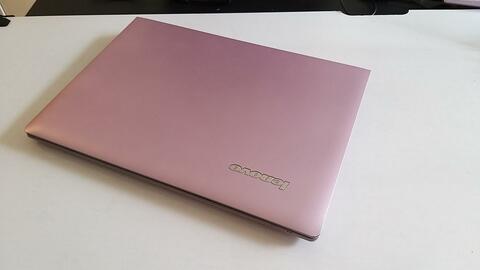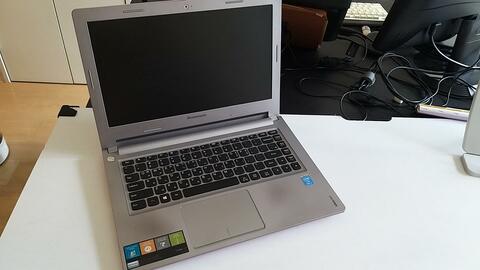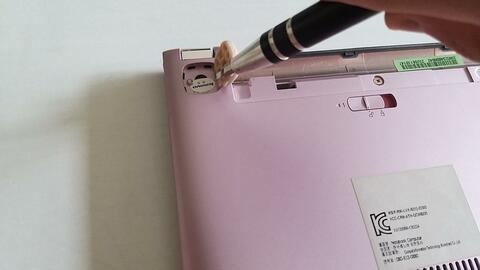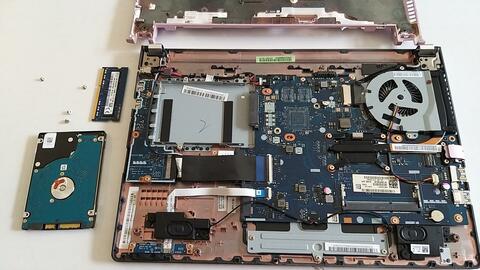Frankensteining a Salvaged Laptop to boost another (more Dumpster Diving shenanigans)
About a month ago, one of my ordinary dumpster diving adventures turned quite interesting with a discovery that was the equivalent of finding some gold while digging for water in a field: a laptop, complete with all the parts laying bare in the trash.

Compared to my more regular findings of discarded parts, cables and maybe the occasional WiFi AP, finding a computer like this is downright the jackpot of the lottery, so you can imagine how I felt to uncover that one. Upon closer inspection, I came to find it was a Lenovo IdeaPad S310, a consumer-grade laptop built sometime in 2014-15 that appears to try to please more the looks than the hardware specifications themselves.
The design seems to have borrowed from the contemporary early Chromebooks, aiming for a super portable yet usable laptop for the casual internet surfer and movie watcher at home. It came with a Korean keyboard, which is not a problem since its layout is almost identical to the US 105-key one, but it has that annoying trend of switching the F-keys with desktop functions to change the volume or screen brightness, delegating the actual F-keys to a function+key combination, much to the chagrin of a Linux power user.

Still, low specs should never be a reason to dismiss a computer in my book. This was evidenced, for example, in my recent adventure bringing back a 2010, Celeron single-core laptop into business usage. And neither should the flashy pink color of it, because, although not my preferred color, dammit, that machine is beautiful!
So I prepare a live medium of Artix into my trusty USB stick, and moved to start freeing that machine up.
When not even free software can fix your computer
Three minutes into the business, however, and I run into a wall: the monitor won't turn on. LEDs all over the laptop would still blink, and the fan would spin as well, so I know the machine ain't dead, but that monitor would still not even as much as flinch during the boot process. Oops?
Alright, I still have an external monitor and I could simply leave it tethered to it permanently, turning it essentially into a desktop. But at that point, I start to question my own tendency to accumulate stuff: I already have a "desktop-like" laptop hooked on my desk, would I really need to have another one there? In fact, there are limited free time hours in my day to use a computer - would I even be able to use both computers in a day to extract value from having another one?
In the end, I convinced myself that the minimalist's way in this case is the logical thing to do, and it's best to return that machine to the trash as my efforts could not salvage it - hey, had I known I little more in electronics and had a soldering iron, things could've turned more interesting! But before I did so, one thought kept tingling the back of my mind: are you sure there is literally nothing else I can do about this guy?
And then I considered the parts.
Salvaging the remains of a moribund laptop
Alright, so the hard drive seemed to still be in a usable state, but I'd have to test it elsewhere to find out, but would still be worth a shot, since I'm not keeping this laptop anyway. but as everything else is pretty much integrated, is there anything else that could be saved from it? I wasn't feeling brave enough to try to pry away the chipset, wireless card or fan.
However, there is still the RAM.
Come to think of it, this fella came with 4GB in a single channel, and uses a DDR3 technology that still seems to be abundant in the wild. And just as I was thinking about what could I do with that spare RAM chip, my thoughts turned out to yet another machine that I had salvaged months earlier from the same trash: my Lenovo Celeron Laptop that I used when first trying out FreeBSD. The two are also from a similar age range. Could their RAM be compatible?
According to the official Lenovo documentation, yes they are.
That's it, I'm going to Frankenstein this broken laptop into my currently weak laptop by buffing it up with additional memory. This would make it hold a whopping 8GB, enough to do all my intended work over there with very little requirement for swapping. The first step is to take apart the lid from the rest of the laptop. Usually this means removing some screws from the back of the laptop, but for some reason, with this computer having a completely flat back I can't find anything to remove.
Thankfully, Lenovo provides a very good end-user manual that describes how to pretty much disassemble the entire thing, which helped quite a lot. Turns out that the screws are hidden beneath the rubber "feet" of laptop, which you have to pull out to open. Unsurprisingly, when you do so, you're faced with those classic "VOID IF REMOVED" stickers preventing user repair, but the machine is broken already anyway, so fuck it.

After this, the rest of the process was pretty easy: find out where is the HDD casing, unscrew it, detach it, remove the drive from the casing, and that's it. For the memory, it was a matter of detaching the chip from the prongs that held it and removing it from the bay. Parts salvaged successfully!

More power to the old computer
The "transplanting" part of the process was pretty easy. The only notorious issue was that as my original laptop was running a 32-bit version of Alpine Linux, it wouldn't detect the rest of the RAM I provided, hence my need to update it to 64-bit. This also took care of updating it to the latest version of 3.14 which also taught me a few things about how it had changed between these versions.
My alpine laptop now runs confortably on 8 gigs for an already pretty lightweight operating system, which makes it really fly in comparison to other systems I had used in the past. This RAM boost also raises another interesting point: this machine now is on par as far as memory is concerned with other contemporary machines I have at work or even those available as new at stores. In other words, it's now a keeper machine, not just an experimental tester one.
It's really exciting to have done what was essentially obtain a modern machine completely for free from parts recovered from the dumpster. Point for the environment, one computer less discarded and one less computer bought from a store. Point for my finances for not spending a single dime for hardware, and point for Linux again for enabling everything to work smoothly.
Have you ever "frankensteined" a machine for parts and upgrades into another one? How did it work? Did you use an older machine of yourself, or another relative's one? Let me know on Mastodon!
This post is number #23 of my #100DaysToOffload project. Follow my progress through Mastodon!
Last updated on 07/28/21